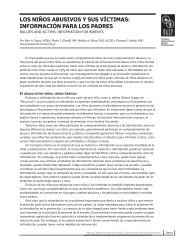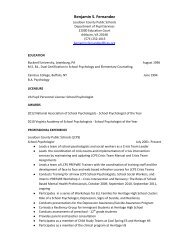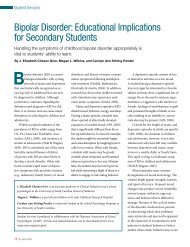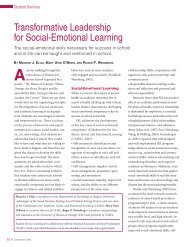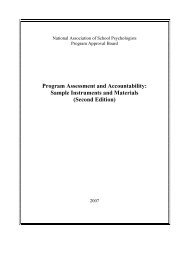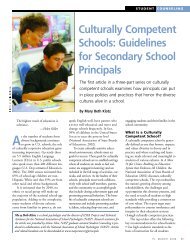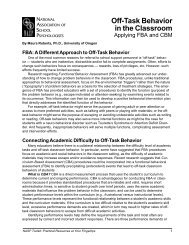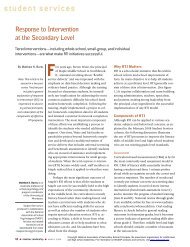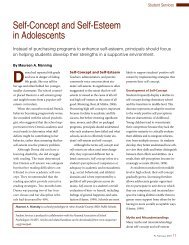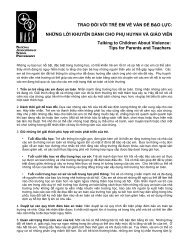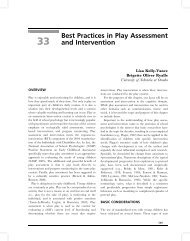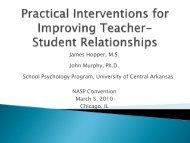Chapter 1 - National Association of School Psychologists
Chapter 1 - National Association of School Psychologists
Chapter 1 - National Association of School Psychologists
Create successful ePaper yourself
Turn your PDF publications into a flip-book with our unique Google optimized e-Paper software.
<strong>Chapter</strong> 1<br />
How Children Emerge in Literacy<br />
Dr. Smith says he does not remember how he learned to read;<br />
he thought it seemed to have occurred naturally, like eating.<br />
Why can’t he recall?<br />
Emergent literacy is a term coined by Marie Clay (1966) that refers to the beginnings<br />
<strong>of</strong> literacy or the process <strong>of</strong> becoming literate. Children begin to develop the precursors <strong>of</strong><br />
literacy long before they walk into a classroom at school. Many <strong>of</strong> us cannot recall when<br />
or how we learned to read. For many <strong>of</strong> us, our memories do not take us back to a time<br />
before we began reading, so it is difficult to describe, even from our own experiences, the<br />
path to becoming a reader.<br />
The majority <strong>of</strong> school psychologists and others working in a consultant role (with the<br />
exception <strong>of</strong> reading specialists) know very little about how reading develops and therefore<br />
cannot answer many questions regarding developmental expectations <strong>of</strong> children at various<br />
ages and grade levels. <strong>School</strong> psychologists, in particular, are expected to have a strong<br />
understanding about child development and human behavior, and they are likely to be<br />
approached about developmental and behavioral issues that are academically related. This<br />
chapter is primarily intended to provide school psychologists and other consultants with<br />
an understanding <strong>of</strong> how reading typically develops. Precursors <strong>of</strong> reading development<br />
such as oral language, vocabulary, and concepts about print are discussed; critical component<br />
skills and how they are connected are described in detail. These include phonemic<br />
awareness, alphabetic principle, phonological decoding, and orthographic processing, followed<br />
by oral reading development, reading fluency, reading vocabulary, and reading comprehension.<br />
Instruction on how to teach these skills effectively is presented in section 2 <strong>of</strong><br />
this book.<br />
Laurice M. Joseph, PhD 15
Understanding, Assessing, and Intervening on Reading Problems<br />
LANGUAGE DEVELOPMENT<br />
Miss Jones, a preschool teacher, was amazed how well Julio, a three-year-old boy, was able to<br />
predict what was going to happen next in a mystery story she was reading to the children.<br />
How might this happen?<br />
Language development is one <strong>of</strong> the most critical precursors to developing literacy skills<br />
with ease. Many practitioners view oral language as a naturally developing skill and reading<br />
as a skill that needs to be taught. Certainly, reading is a skill that needs to be taught, but<br />
so does oral language, in a sense, because it does not develop as naturally as one may envision.<br />
Many educators would agree that language development begins in the home during<br />
instances when children have the opportunities to observe, listen, and use language to<br />
communicate with others and to receive communication from others. Language is most<br />
likely to develop through verbal interactions between caregivers (parents) and their children.<br />
Quality, as well as quantity, <strong>of</strong> verbal interactions is critical. These interactions establish<br />
the foundation (‘‘background knowledge’’) on which children can build.<br />
Quality <strong>of</strong> verbal interactions in the home refers to the types <strong>of</strong> dialogues that occur<br />
between parents or caregivers and their children. Many types <strong>of</strong> verbal interactions occur<br />
between parents and children, but those that help children reason and form verbal relationships<br />
about events or activities are considered to be rich or high-quality types <strong>of</strong> interactions<br />
(Nelson, 1996). High-quality verbal parent-to-child interactions include asking<br />
children questions that encourage an elaborate response or one that is beyond a yes or no<br />
response. Encouraging children to share in detail their own memories about an event such<br />
as a visit to the zoo or a vacation, or how they made an object with blocks or helped<br />
make cookies, would be considered eliciting high-quality verbal interactions (Nelson,<br />
1996). Often, as children attempt to interact about a past trip or how they made something,<br />
they may need prompting to remember an event that occurred on their trip or a<br />
step in making an object. When parents prompt children in this manner, they are helping<br />
their children reason and organize information.<br />
High-quality verbal interactions can also occur during an activity that the parents and<br />
their child are currently doing together. For instance, putting a puzzle together can be a<br />
rich opportunity to model and elicit oral language. Before beginning to put the puzzle<br />
together, parents can vocalize a strategy for arranging the pieces or plan to work from the<br />
outside to the inside; better yet, they can ask the child for ideas on how to proceed with<br />
the task. During the activity, parents can verbalize their thinking about a puzzle piece and<br />
why they think it may fit with another piece and then encourage the child to verbalize his<br />
or her thinking while working on putting the pieces together.<br />
Storytelling and storybook reading are two high-quality activities that many young<br />
children repeatedly enjoy. During these activities, children can discover the meanings <strong>of</strong><br />
words, label pictures, make predictions, and form cause-and-effect relationships. Guiding<br />
children through a story by asking questions and providing them with feedback and then<br />
16 <strong>National</strong> <strong>Association</strong> <strong>of</strong> <strong>School</strong> <strong>Psychologists</strong>
encouraging extensions on their responses stimulate high-quality verbal interactions<br />
(Thomas, 1985).<br />
In general, high-quality verbal interactions not only build vocabulary and sentence formation<br />
skills but also foster analytical and synthetic reasoning skills as well as the use <strong>of</strong><br />
language as a tool for problem solving. These types <strong>of</strong> rich dialogues were found to contribute<br />
to children’s linguistic and cognitive growth (Nelson, 1996).<br />
The quantity <strong>of</strong> verbal interactions is also very important. In fact, Hart and Risley<br />
(1995) reported that children who resided in families that listened and talked to one<br />
another frequently had higher linguistic and vocabulary skills than children who engaged<br />
in limited verbal communications. These differences particularly occurred between social<br />
classes (Alexander, Entwisle, & Olson, 2001). Parents who had pr<strong>of</strong>essional careers and<br />
high socioeconomic status tended to listen and talk to their children more frequently and<br />
engage in more high-quality verbal interactions than parents who had working-class jobs<br />
or parents who were on welfare. Thus, the children from pr<strong>of</strong>essional families entered<br />
school knowing more than double the number <strong>of</strong> vocabulary words that children from<br />
working-class and welfare families did (Graves & Slater, 1987; Hart & Risley, 1995).<br />
Language gaps between children residing in low socioeconomic households and those<br />
residing in high socioeconomic households continue into formal school years despite exposures<br />
and opportunities to similar types <strong>of</strong> instruction. This finding was very prevalent in a<br />
study conducted by Entwisle, Alexander, and Olson (1997). These researchers found that<br />
children who resided in middle-class families were likely to engage in more enriching<br />
activities outside <strong>of</strong> school during weekends and vacation times than children residing in<br />
low-income families. Enriching activities included going to the library, museums, historical<br />
sites such as national monuments, and family vacations. These findings should be interpreted<br />
with caution, as this does not necessarily mean that children from low socioeconomic<br />
families speak less than children from high socioeconomic families. Children from<br />
working-class and welfare families should not automatically be classified as poor readers,<br />
and children from pr<strong>of</strong>essional families should not automatically be classified as pr<strong>of</strong>icient<br />
readers. Much <strong>of</strong> the vocabulary found in books at the preprimer and primer levels are<br />
words that are in most all children’s oral language repertoires despite their parents’ socioeconomic<br />
status (McCormick, 2003).<br />
Structures <strong>of</strong> Spoken Language<br />
<strong>Chapter</strong> 1: How Children Emerge in Literacy<br />
The structures <strong>of</strong> spoken language are learned at very early ages even though children<br />
may not yet be able to identify parts <strong>of</strong> speech (Bloom, Barss, Nicol, & Conway, 1994).<br />
Through frequent verbal interactions, children begin to imitate their parents’ speech and<br />
eventually learn syntax (sentence structure) and semantics (meaning; Golink<strong>of</strong>f & Hirsch-<br />
Pasek, 1995). Very young children may say a phrase or a sentence that is <strong>of</strong>ten stated by<br />
their parents, such as ‘‘Mommy go bye-bye.’’ They listen to how language is arranged in<br />
a certain way so that it makes sense or conveys statements that are easily understood.<br />
Laurice M. Joseph, PhD 17
Understanding, Assessing, and Intervening on Reading Problems<br />
This is evident as children’s sentence length grows from two words to four, and so on. As<br />
children continue to become linguistically sophisticated, their spoken language reflects a<br />
more complex and wider range <strong>of</strong> grammatical structures. Chaney (1992) found that syntactic<br />
and semantic language skills were predictors <strong>of</strong> performance in phonological skills<br />
for a sample <strong>of</strong> preschoolers.<br />
Pragmatics <strong>of</strong> Language<br />
Young children also learn the various uses <strong>of</strong> language or the pragmatics <strong>of</strong> language<br />
(Ninio & Snow, 1996). Very young children soon learn to use their words as a means to communicate<br />
their needs or make requests instead <strong>of</strong> crying, babbling, or gesturing. They also<br />
begin to learn how adults communicate with each other during conversational situations, such<br />
as at the dinner table. They soon realize that language is used in genres such as storytelling or<br />
storybook reading time. Young children not only discover the pragmatics <strong>of</strong> language but also<br />
begin to think about and manipulate language, in a process <strong>of</strong> developing metalinguistic skills.<br />
Language and Reading<br />
Having adequate language skills, including vocabulary, can help children read and<br />
comprehend text with more ease when they encounter printed words (de Jong & Leseman,<br />
2001; Roth, Speece, & Cooper, 2002). Learning how to read does not come naturally to<br />
children, but they will encounter the task with more ease if they can match printed words<br />
and their meanings to words and meanings they have in their oral language repertoires<br />
(McCormick, 2003). Knowledge <strong>of</strong> oral language provides a way for children to self-check<br />
words they are reading and determine if they sound syntactically or semantically correct.<br />
Oral language in this context does not necessarily refer to children who are observed to<br />
talk aloud <strong>of</strong>ten. Some children are quiet by nature and engage in private speech and subvocalizations<br />
at significantly higher rates than overt vocalizations.<br />
Acquiring language is not a guarantee that children will become pr<strong>of</strong>icient readers,<br />
even though language correlates significantly with reading performance (Scarborough,<br />
1998). Written language and oral language structures differ with regard to the way sentence<br />
patterns are constructed. This is one <strong>of</strong> the reasons children should listen to storybooks<br />
being read to them (McCormick, 2003). Reading aloud is a very important activity<br />
if you want to expose children through oral language to the way sentence patterns are<br />
constructed in written language before children actually read the printed words in a book.<br />
CRITICAL COMPONENT SKILLS<br />
Reading is a complex activity involving several component skills (<strong>National</strong> Reading<br />
Panel, 2000). Research has shown that children who do not learn basic early component<br />
skills <strong>of</strong> reading are likely to be at a disadvantage during their formal schooling years and<br />
beyond (Moats, 1999). Each <strong>of</strong> these skills is necessary but alone is not sufficient to allow<br />
18 <strong>National</strong> <strong>Association</strong> <strong>of</strong> <strong>School</strong> <strong>Psychologists</strong>
a child to become a pr<strong>of</strong>icient reader. The goal <strong>of</strong> reading is to move from learning to read<br />
to reading to learn. Several <strong>of</strong> the component skills discussed in this section need to be<br />
automatized or appropriated if learners are to use reading as a tool for obtaining information<br />
or as a recreational activity that brings them pleasure and entertainment.<br />
Concepts About Print<br />
While watching a video in which he was reading a book to his nine-month-old daughter<br />
as they sat on the couch, Sam reported that he noticed his infant daughter’s head tilted<br />
and her eyes moved from left to right.<br />
Can infants read?<br />
Although a picture may be worth a thousand words, it is important that children eventually<br />
realize that it is printed words, not pictures, that reveal a message. When children<br />
have concepts about print, it means that they are able to distinguish words from pictures,<br />
know that a book has a front and a back, know that books are read right side up, and<br />
know that printed words across a page in a book are read from left to right and top to bottom<br />
(Clay, 1993). Children develop concepts about print very early, <strong>of</strong>ten at home before<br />
they enter formal schooling (Morrow & Young, 1997). According to a report provided by<br />
the <strong>National</strong> Research Council (edited by Snow, Burns, & Griffin, 1998), children from<br />
birth through three years <strong>of</strong> age begin to develop concepts about print as they recognize<br />
specific books by the cover, label pictured objects in books, and pretend to read books.<br />
It is not the presence <strong>of</strong> the print materials that is most critical, although that is<br />
important. Rather, it is the quantity and quality <strong>of</strong> interactions with print that shape early<br />
reading development (Mason & Allen, 1986). Concepts about print are best learned<br />
through interactions with parents or caregivers during routine storybook reading time.<br />
This is the time when parents demonstrate how to hold a book, how to turn pages, and<br />
how to read words from left to right, <strong>of</strong>ten by running their index finger across the page in<br />
a left to right sweeping motion as they read the words. Children are also prompted to put<br />
their fingers on a page and point to the words on a page rather than the pictures.<br />
Concepts about print can be taught during playtime or in a preschool classroom through<br />
make-believe play activities such as working in a restaurant as a waiter taking orders or as<br />
a customer reading and ordering from the menu or pretend-working in a post <strong>of</strong>fice where<br />
letters are addressed and stamped. These types <strong>of</strong> activities were found to be very effective<br />
in helping preschoolers gain concepts about print (Neuman & Roskos, 1992).<br />
Phonological Awareness<br />
<strong>Chapter</strong> 1: How Children Emerge in Literacy<br />
Sally can identify beginning and ending sounds, but she has difficulty<br />
identifying the middle sounds in spoken words.<br />
What does this mean?<br />
The acquisition <strong>of</strong> phonological awareness skills plays a primary role later in recognizing<br />
and comprehending printed text (Torgesen & Mathes, 2000). Phonological awareness<br />
Laurice M. Joseph, PhD 19
Understanding, Assessing, and Intervening on Reading Problems<br />
is alertness to the sounds in spoken language. It is also the operation and manipulation <strong>of</strong><br />
sounds in spoken words. Numerous studies have revealed that phonological awareness,<br />
rather than intellectual ability, is a better predictor <strong>of</strong> word reading performance for children<br />
in the early primary grades (e.g., Share, McGee, & Silva, 1989; Siegel, 1988;<br />
Stanovich, Cunningham, & Freeman, 1984; Stanovich & Siegel, 1994; Vellutino,<br />
Scanlon, & Lyon, 2000). Explicit training in phonological awareness during the preschool<br />
and kindergarten years may also have the potential to mediate the effects <strong>of</strong> poverty<br />
(Kaplan & Walpole, 2005).<br />
According to Lundberg, Frost, and Peterson (1988), phonological awareness involves<br />
the following developmental progression <strong>of</strong> skills: (1) rhyming, especially the production<br />
<strong>of</strong> rhymes, (2) hearing individual syllables in words, (3) hearing initial sounds <strong>of</strong> words,<br />
and (4) hearing sounds within words. Rhyme production may involve having children<br />
co-construct a jingle or a poem by taking turns with their parents or teachers creating a<br />
phrase that rhymes with the previous phrase. Eventually, young children will feel comfortable<br />
producing their own rhymes without assistance from others. Children can learn to<br />
attend to individual syllables in words by clapping or counting the syllables. Children can<br />
attend to initial sounds in words by being shown a picture <strong>of</strong> an object and saying the<br />
word it represents, followed by its beginning sound. In that activity, three additional pictures<br />
are presented. One <strong>of</strong> the pictures depicts an object with the same beginning sound<br />
as the first picture presented. Children can circle, point to, or say the word <strong>of</strong> the picture<br />
that has the same beginning sound as the first picture presented. The same activity can be<br />
used to help children attend to ending sounds in words.<br />
Learning to hear sounds within words can be presented through an oddity task or oddone-out<br />
task. Children may be presented with the words sit, fit, kit, and cat and asked to<br />
choose one that sounds different from the others. Generally, children attend to beginning<br />
and ending sounds before attending to middle sounds during phonological awareness<br />
exercises.<br />
According to Lane, Pullen, Eisele, and Jordan (2002), there are four levels <strong>of</strong> phonological<br />
awareness development: (1) Young children first become aware that speech flow is a<br />
collection <strong>of</strong> individual words. (2) Young children distinguish syllables in spoken words followed<br />
by onset and rime activities (intrasyllabic level). For instance, the onset may be the<br />
consonant sound that precedes the vowel, such as the /c/ in the word cat. The rime is the<br />
rest <strong>of</strong> the word, such as /at/ in the word cat. This is considered to be a rather sophisticated<br />
phonological awareness skill because tasks that require onset-rime analysis involve segmentation<br />
<strong>of</strong> syllables. (3) The final level is the phoneme level, which is most commonly<br />
referred to as phonemic awareness and is considered to be the most sophisticated level.<br />
Phonemic awareness is one <strong>of</strong> the most important components <strong>of</strong> phonological awareness<br />
because it has been found to be a critical precursor skill to successful reading and<br />
spelling performance (Ball & Blachman, 1991; Bentin & Leshem, 1993; Byrne & Fielding-<br />
Barnsley, 1991; Griffith, 1991; Hatcher, Hulme, & Ellis, 1994; Juel, 1988; Stahl & Murray,<br />
20 <strong>National</strong> <strong>Association</strong> <strong>of</strong> <strong>School</strong> <strong>Psychologists</strong>
<strong>Chapter</strong> 1: How Children Emerge in Literacy<br />
1994; Tangel & Blachman, 1992). Phonemic awareness is a more specific skill that requires<br />
attention to and manipulation <strong>of</strong> individual sounds <strong>of</strong> spoken words. A phoneme is the smallest<br />
unit <strong>of</strong> sound (an individual sound) in a word. The English language contains approximately<br />
forty-one phonemes.<br />
Daly, Chafouleas, and Skinner (2005) provide a hierarchy <strong>of</strong> phonemic awareness<br />
skills or skills that, more specifically, involve the manipulation <strong>of</strong> individual sounds in<br />
words. The first skill in their hierarchy <strong>of</strong> skills is alliteration. This skill involves having the<br />
child identify and say the first sound in a word, such as saying /c/ for the word cat, and<br />
identifying words that have the same first sound, such as categorizing cap with cat when<br />
the words sun, cap, and dog are presented. The next skill is blending, which consists <strong>of</strong><br />
blending the individual sounds <strong>of</strong> a word to make a whole word, such as /c-a-t/ to form<br />
the word cat. Blending is followed by the child segmenting the sounds <strong>of</strong> a word by clapping<br />
three times as each sound in the word /c-a-t/ is slowly articulated, or by saying each<br />
<strong>of</strong> the individual sounds heard in the word cat.<br />
The final skills in the developmental progression involve deleting, substituting, and<br />
reversing individual sounds in words to make new words. When the word cat is articulated,<br />
children are asked to say the new word when the /c/ sound ‘‘walks away’’ and when the /b/<br />
sound ‘‘comes over to stand’’ in the /c/ place, as in bat. Children may also reverse the<br />
sounds in the word bat to form another word, tab, and add sounds to a word, such as adding<br />
/s/ to the word tab to form the word stab. Among the phonological awareness skills,<br />
Nation and Hulme (1997) found that phoneme segmentation skills were the best predictors<br />
<strong>of</strong> word reading performance for a sample <strong>of</strong> first graders.<br />
Phonemic awareness has been strongly related to phonological memory, especially at<br />
the early ages (Wagner, Torgesen, Laughon, Simmons, & Rashotte, 1993). According to<br />
Torgesen (1988), phonological memory (sometimes called memory span) is a process by<br />
which individuals store phonological codes in their working or short-term memory.<br />
Gathercole and Baddeley (1990) found that deficits in phonological memory did not affect<br />
elementary school-age children’s ability to speak and read known words but did affect their<br />
ability to speak and read words that were unknown to them. Phonological memory becomes<br />
more crucial as children grow older and confront new complex words such as multisyllabic<br />
words. If children are unable to store all <strong>of</strong> the sounds or chunks <strong>of</strong> sounds in their immediate<br />
memories, they may have difficulty blending all <strong>of</strong> the sounds to form a whole word.<br />
Thus, phonological memory is a characteristic that distinguishes good readers from poor<br />
readers (Muter & Snowling, 1998; Swanson, 1992; Torgesen, 1988; Vellutino et al., 1996).<br />
Whereas phonological memory involves the storage <strong>of</strong> phonological codes, rapid naming<br />
refers to the efficient retrieval <strong>of</strong> that phonological information (McDougall, Hulme,<br />
Ellis, & Monk, 1994). In other words, rapid naming is rapidly accessing phonological codes<br />
to speak and read fluently. Rapid naming tasks are timed and typically consist <strong>of</strong> naming<br />
objects, digits, letters, or words quickly or automatically. Children experienced the greatest<br />
difficulty learning to read if they exhibited a combination <strong>of</strong> limited rapid naming and<br />
Laurice M. Joseph, PhD 21
Understanding, Assessing, and Intervening on Reading Problems<br />
phonological awareness skills (Wolf & Bowers, 1999; Bowers & Wolf, 1993). Some investigations<br />
have revealed correlations between rapid naming and phonological awareness,<br />
letter-name knowledge, and very basic decoding skills (Compton, 2003). Others have found<br />
significant relationships between rapid naming and orthographic and reading comprehension<br />
skills (Bowers, 1995; Cutting & Denkla, 2001; Manis, Doi, & Bhadha, 2000). Although<br />
investigations have reported a relationship between rapid naming and other early literacy<br />
skills, some researchers have found that the relationship is stronger for intermediate graders<br />
than it is for primary graders (Kirby, Pfeiffer, & Parrila, 2000).<br />
Orthographic Knowledge<br />
Johnny, a beginning kindergartner, can name all the letters in the alphabet but<br />
does not know the sounds that all the letters make.<br />
Is this ‘‘normal’’?<br />
Orthographic knowledge involves lexical processing <strong>of</strong> words, which means analyzing<br />
the visual or graphic structures <strong>of</strong> letters and words and involves storing these lexical features<br />
in memory (Olson, Forsberg, Wise, & Rack, 1994). At least as early as three years <strong>of</strong><br />
age, children begin attending to letters in names, particularly their own name (Snow,<br />
Burns, & Griffin, 1998). Knowing about letters (graphemes) and noting letter sequences in<br />
words require orthographic skills (Ehri, 1991).<br />
Many young children (four to five years old) may be able to name the letters <strong>of</strong> the<br />
alphabet, either by reciting the alphabet orally or by singing the alphabet song or by looking<br />
at the printed symbols and naming the letters. In some cases, even three-year-olds<br />
have been known to name ten letters <strong>of</strong> the alphabet (Snow et al., 1998). Typically,<br />
children are able to do this before they are able to identify the sounds that the letters represent<br />
(Worden & Boettcher, 1990). Letter naming, especially letter-naming fluency, has<br />
been found to be related to early reading skills (Johnston, Anderson, & Holligan, 1996),<br />
although some claim that the relationship between letter-naming training and word recognition<br />
acquisition is not as strong as the relationship between phoneme awareness and<br />
word recognition acquisition (e.g., Allor, 2002; Ball & Blachman, 1991; McBride-Chang,<br />
1999). However, some earlier investigations reported that training programs that combined<br />
phonemic awareness exercises, such as phoneme segmentation, with letter-shape instruction<br />
produced greater outcomes in early reading acquisition skills than general language<br />
skills instruction (Bentin & Leshem, 1993). Knowledge <strong>of</strong> letter names influences children’s<br />
early attempts to write words (Treiman & Tinc<strong>of</strong>f, 1997).<br />
In their later development <strong>of</strong> orthographic features <strong>of</strong> language, children (particularly<br />
those in the primary grades) begin to note letter sequences or spelling patterns in words and<br />
how combinations or patterns <strong>of</strong> letters are strung together and represent certain sounds.<br />
For instance, when two letters that represent vowel sounds follow one another in the middle<br />
<strong>of</strong> a word such as in the words meat and gait, the sound <strong>of</strong> the first letter representing the<br />
vowel sound is heard rather than the subsequent letter. For the word meat, the long /e/<br />
22 <strong>National</strong> <strong>Association</strong> <strong>of</strong> <strong>School</strong> <strong>Psychologists</strong>
sound is heard, and the long /a/ sound is heard for the word gait. These types <strong>of</strong> spelling patterns<br />
found in words make it possible for words to be learned by analogy and automatically<br />
(McCormick, 2003). For instance, once a learner knows how to read the words main, pain,<br />
and rain, they are likely to learn how to read the word stain with much ease and with little<br />
assistance. Recalling orthographic features <strong>of</strong> words can be challenging when words sound<br />
alike but are spelled differently, such as pane and pain. Orthographic knowledge <strong>of</strong> words also<br />
plays a role in obtaining morphemic (meaning) units <strong>of</strong> words such as prefixes and suffixes<br />
(Frith, 1985; Nagy, Berninger, Abbot, Vaughan, & Vermeulen, 2003).<br />
Alphabetic Principle<br />
In a seminal book about beginning reading, Adams (1990) proclaims that acquiring<br />
phonemic awareness and letter-naming skills eases one’s way to understanding the alphabetic<br />
principle. According to Torgesen and Mathes (2000), phonemic awareness helps<br />
children understand the alphabetic principle, helps children become aware <strong>of</strong> the regular<br />
ways letters represent sounds, and makes it possible to identify words in context even if<br />
they can only be partially sounded out.<br />
The alphabetic principle refers to knowing that there is an association between letters<br />
and sounds or that there are letter-sound relations. One way to learn letter-sound relations<br />
is by having children read alphabet books that contain printed upper- and lowercase letters,<br />
pictures, and words that represent the sounds <strong>of</strong> the respective featured letters. For<br />
instance, to understand that /b/ is for bear, children need to understand that the first sound<br />
in bear is /b/. Some experts have suggested that lowercase letters should be taught first<br />
because the majority <strong>of</strong> words in reading text are printed in lowercase letters (Carnine,<br />
Silbert, Kame’enui, & Tarver, 2004). This may be the case for children who have limited<br />
prerequisite literacy skills, and learning lowercase letters may quickly lead to engaging in<br />
printed text. Children who can make approximately forty letter-sound correspondences in<br />
one minute by the end <strong>of</strong> kindergarten are at an advantage for beginning reading instruction<br />
when they enter first grade (Casey & Howe, 2002). Thus, word reading strategies<br />
begin to develop when children begin to make connections between phonological and<br />
orthographic features <strong>of</strong> language. Blachman, Tangel, Ball, Black, and McGraw (1999)<br />
found that kindergarten children who received a combination <strong>of</strong> phonemic awareness,<br />
letter-naming, and letter-sound training outperformed their peers (control group) in reading<br />
phonetically regular words, reading pseudowords, and spelling basic words.<br />
Phonological Recoding and Decoding<br />
<strong>Chapter</strong> 1: How Children Emerge in Literacy<br />
Mr. Jones reported that Jamie, a first grader, had an ‘‘Aha’’ moment when he<br />
read the word dog for the first time and said, ‘‘Oh, I know this word. I have a pet dog.’’<br />
Why did Jamie say this?<br />
When children encounter printed words and attempt to read the words, they go<br />
through a process <strong>of</strong> phonological recoding, which means they try to recode the printed word<br />
Laurice M. Joseph, PhD 23
Understanding, Assessing, and Intervening on Reading Problems<br />
back to its oral representation (Share, 1995). Similarly, Vandervelden and Siegel (1997)<br />
defined phonological recoding as retrieving the pronunciation <strong>of</strong> a word in one’s oral<br />
vocabulary when it is newly encountered in print through systematic relationships between<br />
letters and sounds. Essentially, the term recoding rather than decoding is used here to<br />
describe the process because children check to see if the word they are reading matches<br />
one in their speaking vocabulary repertoire (Daneman, 1991). This process is a reminder<br />
about the valuable connection between oral and written language.<br />
Many <strong>of</strong> the basic words in print that first graders encounter are words with consonantvowel-consonant<br />
patterns (CVC). These words <strong>of</strong>ten require a one-to-one letter-sound<br />
correspondence. Children are taught to sequentially decode these types <strong>of</strong> printed words by<br />
making one-to-one sequential letter–sound correspondences, such as blending the sounds <strong>of</strong><br />
the letters c-u-p to produce the word cup. At more advanced levels, children hierarchically<br />
decode words by using letters in words to cue the sounds <strong>of</strong> other letters, such as using the letter<br />
‘‘e’’ at the end <strong>of</strong> the word cake to cue them to make a long vowel sound for the letter ‘‘a’’<br />
(McCormick, 2003).<br />
Phonological coding involves applying the alphabetic principle, which is the linking<br />
<strong>of</strong> phonological and orthographic features <strong>of</strong> language. A reciprocal relationship likely<br />
exists between the development <strong>of</strong> spoken and written language. Awareness <strong>of</strong> sounds in<br />
spoken language aids in decoding written language, and developing written language skills<br />
such as reading and writing contributes to growth in oral language (Chase & Tallal,<br />
1991). Perfetti, Beck, Bell, and Hughes (1987) discovered that children’s growth in word<br />
reading skills strengthened their phonological awareness skills.<br />
Word Reading<br />
Tiffany paused when she came across a word that was unfamiliar to her and decided<br />
to use letter-sound correspondence strategies to figure out how to read it.<br />
Is this word recognition or word identification?<br />
Word reading is a more general term that encompasses word recognition and word identification<br />
skills. Often, the terms word recognition and word identification are used synonymously.<br />
McCormick (2003) provides a clear distinction between these two terms. She<br />
defines word recognition as the instant recall <strong>of</strong> words or reading <strong>of</strong> words by sight. Word<br />
identification refers to the instances when the reader needs to access one or more strategies<br />
to aid in reading a word. Children who are pr<strong>of</strong>icient at the use <strong>of</strong> strategy almost make it<br />
seem as if they are reading the words effortlessly, whereas children who have had little experience<br />
with strategy use appear to exert much effort in figuring out how to read a word.<br />
Ehri and McCormick (1998) postulated the following phases <strong>of</strong> word learning: (1) prealphabetic,<br />
(2) partial alphabetic, (3) full alphabetic, (4) consolidated alphabetic, and<br />
(5) automatic. In the prealphabetic stage, children have knowledge <strong>of</strong> logographic features<br />
(word graphic features), and they employ these features to read words. For instance, they may<br />
24 <strong>National</strong> <strong>Association</strong> <strong>of</strong> <strong>School</strong> <strong>Psychologists</strong>
<strong>Chapter</strong> 1: How Children Emerge in Literacy<br />
recognize a word by its shape or length. They do not tend to recognize many words in<br />
context-free situations. Children in this stage do not make letter-sound associations;<br />
however, they may be able to remember and read words that they have been exposed to<br />
repeatedly. In the partial alphabetic stage, children are able to recognize more words in isolation<br />
(context-free situations) as they use more letter cues to recognize words. Some analytical<br />
skills are applied, such as breaking down words into letters and using beginning and ending<br />
sounds to recognize words; however, most words are read by sight. In the next stage<br />
(full alphabetic), students begin to learn and use more letter-sound associations to read<br />
words. Children may be observed to point to each letter <strong>of</strong> a word and decode a word very<br />
slowly using a one-to-one correspondence between letters and sounds. Later, they are able to<br />
decode words more quickly. In this stage, children learn many more words than in previous<br />
stages.<br />
In the consolidated alphabetic stage, children begin to recognize words by analogy,<br />
especially words that share common spelling and sound patterns (sometimes referred to as<br />
phonograms or word family words). For example, children are able to read the word hike<br />
because they already know how to read the words bike and like. Familiar spelling-pattern<br />
units in words, such as those that end in ‘‘ip,’’ are easily pronounced (e.g., sip, dip, and<br />
zip), which makes bigger words, such as skip or zipper, more manageable (less overwhelming)<br />
to decode. Reading a significantly greater number <strong>of</strong> words and reading them more<br />
fluently are evident in this phase.<br />
The final phase <strong>of</strong> word reading is the automatic phase. Most all words are recognized<br />
by sight or effortlessly. Readers have a variety <strong>of</strong> strategies that they systematically apply<br />
when reading words that are unfamiliar. When children learn to read several words, they<br />
are likely to read more words at increasingly higher rates. This phenomenon is what<br />
Stanovich (1986) called the ‘‘Matthew effects <strong>of</strong> reading’’ (good readers get better and<br />
poor readers get poorer).<br />
It is important that children reach the automatic stage <strong>of</strong> word reading so that less <strong>of</strong><br />
their cognitive effort is spent figuring out how to read print. Instead, their effort is spent<br />
obtaining meaning from print. Learning to read, in a sense, is a complex process, because<br />
words may be presented in structurally diverse ways in various genres or types <strong>of</strong> literature;<br />
therefore, it is important that children reach a stage at which they are reading to learn.<br />
This is especially critical during formal schooling, in which reading is required to obtain<br />
information across all academic content areas. Moreover, reading skills have become more<br />
critical beyond formal schooling years as society has advanced technologically.<br />
Word reading and spelling develop closely together. Zutell (1998) describes five stages<br />
<strong>of</strong> spelling development: preliterate, phonetic or letter-name, transitional, syllable juncture<br />
spelling, and conventional spelling. The first stage is called the preliterate stage because<br />
children initially scribble. In this stage, they do not know all the names <strong>of</strong> letters and do<br />
not know any letter-sound relationships. Later in this stage, children begin to write a letter<br />
or letters that represent a sound or word. For instance, children may write the letter that<br />
Laurice M. Joseph, PhD 25
Understanding, Assessing, and Intervening on Reading Problems<br />
their name begins with to represent their entire name or they may spell a word using three<br />
letters even though it is spelled using more letters. For instance, they may spell the word<br />
teacher as ‘‘ter.’’ In stage two, the phonetic or letter-name stage, children can spell words<br />
using appropriate letter-sound associations although they still make errors, such as spelling<br />
‘‘skipt’’ for skipped. Children then move on to a third stage, the transitional stage, when<br />
they <strong>of</strong>ten spell words using medial vowels and produce correct inflectional endings (e.g.,<br />
‘‘ed,’’ ‘‘ing’’). In stage four, syllable juncture spelling, children can spell a large number <strong>of</strong><br />
single and multisyllabic words with high-frequency spelling patterns but still have difficulty<br />
with some complex doubled and unstressed vowels in polysyllabic words. Stage five is the<br />
conventional spelling stage. Children at this stage can correctly spell most words with confusing<br />
patterns, especially if they have had adequate exposure to the words. It is natural<br />
for children to invent the spellings <strong>of</strong> words when they are beginning to attempt to write<br />
words. However, it is important for children to eventually learn to spell conventionally so<br />
they may be able to effectively communicate in written form.<br />
Passage Reading<br />
Before children engage in passage reading, they engage in storybook reading with their<br />
parents, caregivers, or preschool teachers. From many observations <strong>of</strong> very young children,<br />
Sulzby (1985) generated developmental stages <strong>of</strong> how children’s skills emerge in storybook<br />
reading. Beginning at about two to three years <strong>of</strong> age and continuing, children progress in<br />
their storybook reading skills by initially attending to pictures without forming stories yet,<br />
and then by attending to pictures and spontaneously forming oral stories. Soon, children<br />
attend to pictures, and their storytelling fluctuates from spontaneous storytelling to storytelling<br />
that appears as if they are reading text but they are not actually reading print yet.<br />
Children move from attending to pictures and sounding as if they are reading to attending<br />
to print and actually reading text (Sulzby, 1985).<br />
Passage reading is important and should be included in primary grade instruction.<br />
Opportunities to practice reading words in context such as stories help children apply their<br />
word identification and recognition skills as well as their comprehension skills (Carnine<br />
et al., 2004).<br />
Fluency<br />
Jerome reads quickly but his voice sounds monotone.<br />
Is Jerome a fluent reader?<br />
The skill <strong>of</strong> reading fluency is critical to increasing the rate at which text is translated<br />
into spoken language (Torgesen, Rashotte, Alexander, Alexander, & MacPhee, 2003).<br />
Carnine et al. (2004) distinguished between the terms automaticity and fluency. They indicated<br />
that automaticity refers to reading words in isolation very swiftly and without much<br />
26 <strong>National</strong> <strong>Association</strong> <strong>of</strong> <strong>School</strong> <strong>Psychologists</strong>
effort. They further stated that one cannot assume that if children read words automatically<br />
in isolation, they will be able to read words in a passage accurately and quickly.<br />
Nevertheless, increasing word recognition accuracy places children in a better position to<br />
read passages fluently. Fluency refers to reading words in passages in a flowing, accurate,<br />
quick, and expressive manner. Reading with expression (prosody) means exhibiting variations<br />
in pitch, pausing between sentences, stressing syllables, and using intonation that<br />
reflects the statements in the text (Hudson, Lane, & Pullen, 2005). Fluent readers can<br />
read an average <strong>of</strong> at least seventy-five to one hundred words per minute accurately, with<br />
three to five errors on grade-level passage text (Shinn, 1989).<br />
Carnine et al. (2004) suggested that fluency exercises on oral reading passages should<br />
be incorporated in daily lessons until children read approximately 135 words per minute<br />
with 97 percent accuracy using fourth-grade reading materials. Having no errors or minimal<br />
errors in reading is critical to gaining meaning from text (<strong>National</strong> Center for<br />
Educational Statistics, 2002). Children who do not read fluently <strong>of</strong>ten read passages very<br />
slowly, laboring over many words one by one. Reading fluency is a good predictor <strong>of</strong> reading<br />
comprehension performance (<strong>National</strong> Reading Panel, 2000; Rasinski, 1990). Fluency<br />
not only contributes to better comprehension <strong>of</strong> text but also may eliminate frustration<br />
caused by working slowly and needing more time to accomplish assignments, especially in<br />
the intermediate grades (Carnine et al., 2004).<br />
Reading Vocabulary and Comprehension<br />
<strong>Chapter</strong> 1: How Children Emerge in Literacy<br />
When Carisa began to read the new story <strong>of</strong> the week, she told her teacher that she remembered<br />
reading about trains and how they operated in the Polar Express book.<br />
What is Carisa doing?<br />
Knowing the meanings <strong>of</strong> words and concepts and comprehending text are as critical<br />
as knowing how to recognize words and read them fluently. Reading vocabulary and comprehension<br />
are very much related to receptive and expressive language knowledge and<br />
skills. A reciprocal relationship exists between oral and written language growth. An<br />
adequate language base (e.g., vocabulary) eases children’s way into written text. Engaging<br />
in reading and writing activities enhances children’s language knowledge and skills (e.g.,<br />
increasing vocabulary). Children use language skills when, according to McCormick<br />
(2003), they attend to the propositions or the smallest units <strong>of</strong> text information that can<br />
be tested as true or false and stand separately when children attempt to comprehend them.<br />
Children also activate their prior knowledge and experiences, or schemata, when the contents<br />
<strong>of</strong> the text are familiar. Intertextuality is observed when children make connections<br />
between new textual information and textual information that they read in the past<br />
(Short, 1992). Therefore, comprehending text is a complex skill because it involves understanding<br />
text structure, making inferences, knowing word meanings, and relating sentences,<br />
paragraphs, and so forth to each other (Randi, Grigorenko, & Sternberg, 2005).<br />
Laurice M. Joseph, PhD 27
Understanding, Assessing, and Intervening on Reading Problems<br />
WHAT CAN SCHOOL PSYCHOLOGISTS AND OTHER<br />
EDUCATIONAL CONSULTANTS DO?<br />
1. While observing students, attend to where they are developmentally with regard to<br />
prereading and reading skills.<br />
2. Dispel unsupported myths about learning how to read.<br />
3. Help educators incorporate the teaching <strong>of</strong> critical component prereading and reading<br />
skills in their daily lessons.<br />
4. Help educators incorporate basic as well as higher-order reading skills according to<br />
individual students’ needs.<br />
5. Help educators realize the importance <strong>of</strong> teaching to mastery and fluency.<br />
6. Give educators an opportunity to share their instructional reading lessons and materials<br />
and help them engage in continuous enhancement activities so that lessons and<br />
materials are conducive to meeting students’ needs.<br />
SUMMARY POINTS<br />
Language development is related to reading development.<br />
High-quality verbal interaction between caregivers and children refers to helping children<br />
describe events, engage in verbal problem-solving, and form cause-effect<br />
relationships.<br />
Quantity <strong>of</strong> verbal interactions refers to how frequently caregivers listen and talk to their<br />
children.<br />
Acquisition <strong>of</strong> syntactic, semantic, and pragmatic elements <strong>of</strong> oral language eases children’s<br />
path to becoming literate.<br />
Concepts about reading print can be learned very early, especially during storybook<br />
time, when caregivers demonstrate how to hold a book, turn pages, and read words<br />
from left to right.<br />
Phonemic awareness is the alertness to and manipulation <strong>of</strong> sounds in spoken language,<br />
including segmenting and blending <strong>of</strong> sounds.<br />
Orthographic knowledge refers to an awareness <strong>of</strong> how letters are sequenced in words<br />
(spelling patterns).<br />
Alphabetic principle refers to the knowledge that a relationship exists between letters and<br />
sounds. For instance, when children encounter printed words, they recode that word<br />
back to its oral representation.<br />
Fluency includes accuracy, speed, and prosody.<br />
Reading comprehension involves understanding text structure, making inferences,<br />
knowing word meanings, and relating sentences and paragraphs to each other.<br />
QUESTIONS FOR DISCUSSION<br />
1. How do oral language skills, conception <strong>of</strong> ideas expressed in print, and phonological<br />
awareness play a part in reading development?<br />
28 <strong>National</strong> <strong>Association</strong> <strong>of</strong> <strong>School</strong> <strong>Psychologists</strong>
2. What are the differences between phonological recoding and phonological decoding?<br />
3. Distinguish between word recognition and word identification.<br />
4. Why does word recognition promote reading fluency and reading comprehension?<br />
5. How might oral language skills, conception <strong>of</strong> ideas expressed in print, and phonological<br />
awareness also play a part in spelling and writing development?<br />
REFERENCES<br />
<strong>Chapter</strong> 1: How Children Emerge in Literacy<br />
Adams, M. J. (1990). Beginning to Read: Thinking and Learning about Print. Cambridge,<br />
MA: MIT Press.<br />
Alexander, K. L., Entwisle, D. R., & Olson, L. S. (2001). <strong>School</strong>s, achievement, and inequality:<br />
A seasonal perspective. Educational Evaluation and Policy Analysis, 23, 171–191.<br />
Allor, J. H. (2002). The relationship <strong>of</strong> phoneme awareness and rapid naming to reading<br />
development. Learning Disability Quarterly, 25, 47–58.<br />
Ball, E., & Blachman, B. (1991). Does phonemic awareness training in kindergarten make<br />
a difference in early word recognition and developmental spelling? Reading Research<br />
Quarterly, 26, 49–66.<br />
Bentin, S., & Leshem, H. (1993). On the interaction between phonological awareness and<br />
reading acquisition: It’s a two-way street. Annals <strong>of</strong> Dyslexia, 43, 125–148.<br />
Blachman, B. A., Tangel, D. M., Ball, E. W., Black, R., & McGraw, C. K. (1999).<br />
Developing phonological awareness and word recognition skills: A two-year intervention<br />
with low-income, inner city children. Reading and Writing: An Interdisciplinary<br />
Journal, 11, 239–273.<br />
Bloom, P., Barss, A., Nicol, J., & Conway, L. (1994). Children’s knowledge <strong>of</strong> binding<br />
and coreference: Evidence from spontaneous speech. Language, 70, 53–71.<br />
Bowers, P. G. (1995). Tracing symbol naming speed’s unique contributions to reading disabilities<br />
over time. Reading and Writing: An Interdisciplinary Journal, 7, 189–216.<br />
Bowers, P. G., & Wolf, M. (1993). Theoretical links between naming speed, precise timing<br />
mechanisms, and orthographic skill in dyslexia. Reading and Writing: An<br />
Interdisciplinary Journal, 5, 69–85.<br />
Byrne, B., & Fielding-Barnsley, R. (1991). Evaluation <strong>of</strong> a program to teach phonemic<br />
awareness to young children. Journal <strong>of</strong> Educational Psychology, 83, 451–455.<br />
Carnine, D. W., Silbert, J., Kame’enui, E. J., & Tarver, S. G. (Eds.). (2004). Direct instruction<br />
reading. (4th ed.) Upper Saddle River, NJ: Pearson.<br />
Laurice M. Joseph, PhD 29
Understanding, Assessing, and Intervening on Reading Problems<br />
Casey, A., & Howe, K. (2002). Best practices in early literacy skills. In A. Thomas &<br />
J. Grimes (Eds.), Best Practices in <strong>School</strong> Psychology IV. Bethesda, MD: <strong>National</strong><br />
<strong>Association</strong> <strong>of</strong> <strong>School</strong> <strong>Psychologists</strong>.<br />
Chaney, C. (1992). Language development, metalinguistic skills, and print awareness in<br />
3-year-old children. Applied Psycholinguistics, 13, 485–514.<br />
Chase, C. H., & Tallal, P. (1991). Cognitive models <strong>of</strong> developmental reading disorders.<br />
In J. Orbrutz & G. W. Hynd (Eds.), Neuropsychological Foundations <strong>of</strong> Learning<br />
Disabilities (pp. 199–240). San Diego, CA: Academic Press.<br />
Clay, M. (1966). Emergent reading behavior. Unpublished doctoral dissertation,<br />
University <strong>of</strong> Auckland, New Zealand.<br />
Clay, M. (1993). Reading Recovery: A Guidebook for Teachers in Training. Portsmouth, NH:<br />
Heinemann.<br />
Compton, D. L. (2003). Modeling the relationship between growth in rapid naming speed<br />
and growth in decoding skill in first-grade children. Journal <strong>of</strong> Educational Psychology,<br />
95, 225–239.<br />
Cutting, L. E., & Denkla, M. B. (2001). The relationship <strong>of</strong> rapid serial naming and word<br />
reading in normally developing readers: An exploratory model. Reading and Writing:<br />
An Interdisciplinary Journal, 14, 673–705.<br />
Daly, E. J., III, Chafouleas, S., & Skinner, C. H. (2005). Interventions for Reading Problems:<br />
Designing and Evaluating Effective Strategies. New York: Guilford Press.<br />
Daneman, M. (1991). Individual differences in reading skills. In R. Barr, M. L. Kamil,<br />
P. Mosenthal, & P. D. Pearson (Eds.), Handbook <strong>of</strong> Reading Research (Vol. 11, pp. 512–<br />
538). New York: Longman.<br />
de Jong, P. F., & Leseman, P. M. (2001). Lasting effects <strong>of</strong> home literacy on reading<br />
achievement in school. Journal <strong>of</strong> <strong>School</strong> Psychology, 39, 389–414.<br />
Ehri, L. C. (1991). Development <strong>of</strong> the ability to read words. In R. Barr, M. L. Kamil,<br />
P. B. Mosenthal, & P. D. Pearson (Eds.), Handbook <strong>of</strong> Reading Research (Vol. 11,<br />
pp. 383–417). New York: Longman.<br />
Ehri, L. C., & McCormick, S. (1998). Phases <strong>of</strong> word learning: Implications for instruction<br />
with delayed and disabled readers. Reading and Writing Quarterly, 14, 135–163.<br />
Entwisle, D., Alexander, K. L., & Olson, L. (1997). Children, <strong>School</strong>s, and Inequality.<br />
Boulder, CO: Westview.<br />
30 <strong>National</strong> <strong>Association</strong> <strong>of</strong> <strong>School</strong> <strong>Psychologists</strong>
<strong>Chapter</strong> 1: How Children Emerge in Literacy<br />
Frith, V. (1985). Beneath the surface <strong>of</strong> developmental dyslexia. In K. E. Patterson, J. C.<br />
Marshall & M. Coltheart (Eds.), Surface Dyslexia (pp. 301–330). London: Erlbaum.<br />
Gathercole, S. E., & Baddeley, A. D. (1990). Phonological memory deficits in language<br />
disordered children: Is there a causal connection? Journal <strong>of</strong> Memory and Language, 29,<br />
336–360.<br />
Golink<strong>of</strong>f, R. M., & Hirsch-Pasek, K. (1995). Reinterpreting children’s sentence comprehension:<br />
Toward a new framework. In B. MacWhinney & P. Fletcher (Eds.),<br />
Handbook <strong>of</strong> Child Language. Oxford, U.K.: Blackwell.<br />
Graves, M. F., & Slater, W. H. (1987, April). Development <strong>of</strong> reading vocabularies in<br />
rural disadvantaged students, intercity disadvantaged students, and middle class suburban<br />
students. Paper presented at AERA conference, Washington, D.C.<br />
Griffith, P. (1991). Phonemic awareness helps first graders invent spellings and third<br />
graders remember correct spellings. Journal <strong>of</strong> Reading Behavior, 23, 215–233.<br />
Hart, B., & Risley, T. R. (1995). Meaningful Differences in the Everyday Experience <strong>of</strong> Young<br />
American Children. Baltimore: Brookes.<br />
Hatcher, P., Hulme, C., & Ellis, A. W. (1994). Ameliorating reading failure by integrating<br />
the teaching <strong>of</strong> reading and phonological skills: The phonological linkage hypothesis.<br />
Child Development, 65, 41–57.<br />
Hudson, R. F., Lane, H. B., & Pullen, P. C. (2005). Reading fluency assessment and<br />
instruction: What, why, and how? The Reading Teacher, 58, 702–714.<br />
Johnston, R. S., Anderson, M., & Holligan, C. (1996). Knowledge <strong>of</strong> the alphabet and<br />
explicit awareness <strong>of</strong> phonemes in prereaders: The nature <strong>of</strong> the relationship. Reading<br />
and Writing: An Interdisciplinary Journal, 8, 217–234.<br />
Juel, C. (1988). Learning to read and write: A longitudinal study <strong>of</strong> 54 children from first<br />
through fourth grades. Journal <strong>of</strong> Educational Psychology, 80, 417–447.<br />
Kaplan, D., & Walpole, S. (2005). A stage-sequential model <strong>of</strong> reading transitions:<br />
Evidence from the early childhood longitudinal study. Journal <strong>of</strong> Educational Psychology,<br />
97, 551–563.<br />
Kirby, J. R., Pfeiffer, S. L., & Parrila, R. K. (2000). Naming speed and phonological awareness<br />
as predictors <strong>of</strong> reading development. Journal <strong>of</strong> Educational Psychology, 95, 453–464.<br />
Lane, H. B., Pullen, P. C., Eisele, M. R., & Jordan, L. (2002). Preventing reading failure:<br />
Phonological awareness assessment and instruction. Preventing <strong>School</strong> Failure, 46, 101–110.<br />
Laurice M. Joseph, PhD 31
Understanding, Assessing, and Intervening on Reading Problems<br />
Lundberg, I., Frost, J., & Peterson, O. P. (1988). Effects <strong>of</strong> an extensive program for stimulating<br />
phonological awareness in preschool children. Reading Research Quarterly, 23,<br />
204–284.<br />
Manis, F. R., Doi, L. M., & Bhadha, B. (2000). Naming speed, phonological awareness, and<br />
orthographic knowledge in second graders. Journal <strong>of</strong> Learning Disabilities, 33, 325–333.<br />
Mason, J. M., & Allen, J. (1986). A review <strong>of</strong> emergent literacy with implications for<br />
research and practice in reading. In E. Z. Rothkopf (Ed.), Review <strong>of</strong> Research in<br />
Education. Washington, D.C.: American Educational Research <strong>Association</strong>.<br />
McBride-Chang, C. (1999). The ABCs <strong>of</strong> the ABCs: The development <strong>of</strong> letter-name and<br />
letter-sound knowledge. Merrill-Palmer Quarterly, 45, 285–307.<br />
McCormick, S. (Ed.). (2003). Instructing Students Who Have Literacy Problems. Upper<br />
Saddle River, NJ: Pearson.<br />
McDougall, S., Hulme, C., Ellis, A., & Monk, A. (1994). Learning to read: The role <strong>of</strong><br />
short-term memory and phonological skills. Journal <strong>of</strong> Experimental Child Psychology,<br />
58, 112–133.<br />
Moats, L. C. (1999). Teaching Reading is Rocket Science: What Expert Teachers <strong>of</strong> Reading<br />
Should Know and be Able to Do. New York: American Federation <strong>of</strong> Teachers.<br />
Morrow, L., & Young, J. (1997). A family literacy program connecting school and home:<br />
Effects on attitude, motivation, and literacy achievement. Journal <strong>of</strong> Educational<br />
Psychology, 89, 736–742.<br />
Muter, V., & Snowling, M. (1998). Concurrent and longitudinal predictors <strong>of</strong> reading:<br />
The role <strong>of</strong> metalinguistic and short-term memory skills. Reading Research Quarterly,<br />
33, 320–337.<br />
Nagy, W., Berninger, V., Abbot, R., Vaughan, K., & Vermeulen, K. (2003). Relationship<br />
<strong>of</strong> morphology and other language skills in at-risk second-grade readers and at-risk<br />
fourth-grade writers. Journal <strong>of</strong> Educational Psychology, 95, 730–742.<br />
Nation, K., & Hulme, C. (1997). Phonemic segmentation, not onset-rime segmentation,<br />
predicts early reading and spelling skills. Reading Research Quarterly, 32, 154–167.<br />
<strong>National</strong> Center for Educational Statistics. (2002). <strong>National</strong> Assessment <strong>of</strong> Educational Progress.<br />
Retrieved July 20, 2005 from www.nces.ed.gov<br />
<strong>National</strong> Reading Panel. (2000). Teaching Children to Read: An Evidence-Based Assessment<br />
<strong>of</strong> the Scientific Research Literature on Reading and its Implications for Reading<br />
32 <strong>National</strong> <strong>Association</strong> <strong>of</strong> <strong>School</strong> <strong>Psychologists</strong>
<strong>Chapter</strong> 1: How Children Emerge in Literacy<br />
Instruction. Washington, D.C.: NICH. Retrieved July 26, 2005 from www.nichd.nih.gov<br />
/publications/nrp/smallbook.htm<br />
Nelson, K. (1996). Language in Cognitive Development: The Emergence <strong>of</strong> the Mediated Mind.<br />
New York: Cambridge University Press.<br />
Neuman, S., & Roskos, K. (1992). Literacy objects as cultural tools: Effects on children’s<br />
literacy behaviors in play. Reading Research Quarterly, 27, 203–225.<br />
Ninio, A., & Snow, C. E. (1996). Pragmatic Development. Boulder, CO: Westview.<br />
Olson, R., Forsberg, H., Wise, B., & Rack, J. (1994). Measurement <strong>of</strong> word recognition,<br />
orthographic, and phonological skills. In G. R. Lyon (Ed.), Frames <strong>of</strong> Reference for the<br />
Assessment <strong>of</strong> Learning Disabilities. New Views on Measurement Issues (pp. 243–277).<br />
Baltimore: Brookes.<br />
Perfetti, C., Beck, L., Bell, L., & Hughes, C. (1987). Children’s reading and development<br />
<strong>of</strong> phonological awareness. Merrill-Palmer Quarterly, 33, 39–75.<br />
Randi, J., Grigorenko, E. L., & Sternberg, R. J. (2005). Revisiting definitions <strong>of</strong> reading<br />
comprehension: Just what is reading comprehension anyway? In S. E. Israel, C. C.<br />
Block, K. L. Bauserman, & K. Kinnucan-Welsch (Eds.), Metacognition in Literacy<br />
Learning: Theory, Assessment, Instruction, and Pr<strong>of</strong>essional Development (pp. 19–40).<br />
Mahwah, NJ: Erlbaum.<br />
Rasinski, T. (1990). Effects <strong>of</strong> repeated reading and listening while reading on reading fluency.<br />
Journal <strong>of</strong> Educational Research, 83, 147–150.<br />
Roth, F. P., Speece, D. L., & Cooper, D. H. (2002). A longitudinal analysis <strong>of</strong> the connection<br />
between oral language and early reading. Journal <strong>of</strong> Educational Research, 95, 259–<br />
272.<br />
Scarborough, H. S. (1998). Early identification <strong>of</strong> children at risk for reading disabilities:<br />
Phonological awareness and some other promising predictors. In B. K. Shapiro, P. J.<br />
Accardo, & A. J. Capute (Eds.), Specific Reading Disability: A View <strong>of</strong> the Spectrum<br />
(pp. 77–121). Timonium, MD: York Press.<br />
Share, D. L. (1995). Phonological recoding and self-teaching: Sine qua non <strong>of</strong> reading<br />
acquisition. Cognition, 55, 151–218.<br />
Share, D. L., McGee, R., & Silva, P. A. (1989). IQ and reading progress: A test <strong>of</strong> the<br />
capacity notion <strong>of</strong> IQ. Journal <strong>of</strong> the American Academy <strong>of</strong> Child and Adolescent<br />
Psychiatry, 28, 97–100.<br />
Laurice M. Joseph, PhD 33
Understanding, Assessing, and Intervening on Reading Problems<br />
Shinn, M. R. (Ed.). (1989). Curriculum-Based Measurement: Assessing Special Children.<br />
New York: Guilford Press.<br />
Short, K. G. (1992). Intertextuality: Searching for patterns that connect. In C. K. Kinzer<br />
& D. J. Leu (Eds.), Literacy Research, Theory, and Practice: Views from Many<br />
Perspectives (pp. 187–197). Chicago: <strong>National</strong> Reading Conference.<br />
Siegel, L. S. (1988). Evidence that IQ scores are irrelevant to the definition and analysis<br />
<strong>of</strong> reading disability. Canadian Journal <strong>of</strong> Psychology, 42, 201–215.<br />
Snow, C. E., Burns, S., & Griffin, P. (1998). Preventing Reading Difficulties in Young<br />
Children. Washington, D.C.: <strong>National</strong> Academy Press.<br />
Stanovich, K. E. (1986). Matthew effects on reading: Some consequences <strong>of</strong> individual differences<br />
in the acquisition <strong>of</strong> literacy. Reading Research Quarterly, 21, 360–407.<br />
Stanovich, K. E., & Siegel, L. S. (1994). Phenotypic performance pr<strong>of</strong>ile <strong>of</strong> children with<br />
reading disabilities: A regression-based test <strong>of</strong> phonological-core difference model.<br />
Journal <strong>of</strong> Educational Psychology, 86, 24–53.<br />
Stanovich, K. E., Cunningham, A. E., & Freeman, J. (1984). Intelligence, cognitive skills,<br />
and early reading progress. Reading Research Quarterly, 14, 278–303.<br />
Stahl, S. A., & Murray, B. A. (1994). Phonological awareness and its relationship to early<br />
reading. Journal <strong>of</strong> Educational Psychology, 86, 221–234.<br />
Sulzby, E. (1985). Children’s emergent reading <strong>of</strong> favorite storybooks: A developmental<br />
study. Reading Research Quarterly, 20, 458–481.<br />
Swanson, H. L. (1992). Generality and modifiability <strong>of</strong> working memory among skilled<br />
and less skilled readers. Journal <strong>of</strong> Educational Psychology, 84, 473–488.<br />
Tangel, D., & Blachman, B. (1992). Effect <strong>of</strong> phonemic awareness instruction on kindergarten<br />
children’s invented spelling. Journal <strong>of</strong> Reading Behavior, 24, 233–261.<br />
Thomas, K. (1985). Early reading as a social interaction process. Language Arts, 62, 469–475.<br />
Torgesen, J. K. (1988). Studies <strong>of</strong> children with learning disabilities who perform poorly<br />
on memory span tasks. Journal <strong>of</strong> Learning Disabilities, 21, 605–615.<br />
Torgesen, J. K., & Mathes, P. (2000). A Basic Guide to Understanding, Assessing, and<br />
Teaching Phonological Awareness. Austin, TX: PRO-ED.<br />
34 <strong>National</strong> <strong>Association</strong> <strong>of</strong> <strong>School</strong> <strong>Psychologists</strong>
<strong>Chapter</strong> 1: How Children Emerge in Literacy<br />
Torgesen, J. K., Rashotte, C., Alexander, A. W., Alexander, J., & MacPhee, K. (2003).<br />
Progress towards understanding the instructional conditions necessary for remediating<br />
reading difficulties in older children. In B. Foorman (Ed.), Preventing and Remediating<br />
Reading Difficulties: Bringing Science to Scale (pp. 275–298). Baltimore: York Press.<br />
Treiman, R., & Tinc<strong>of</strong>f, R. (1997). The fragility <strong>of</strong> alphabetic principle. Children’s knowledge<br />
<strong>of</strong> letter names can cause them to spell syllabically rather than alphabetically.<br />
Journal <strong>of</strong> Experimental Child Psychology, 64, 425–451.<br />
Vandervelden, M. C., & Siegel, L. S. (1997). Teaching phonological processing skills in<br />
early literacy: A developmental approach. Learning Disabilities Quarterly, 20, 63–81.<br />
Vellutino, F. R., Scanlon, D. M., & Lyon, G. R. (2000). Differentiating between difficult to<br />
remediate and readily remediated poor readers: More evidence against the IQ-achievement<br />
discrepancy definition <strong>of</strong> reading disability. Journal <strong>of</strong> Learning Disabilities, 33, 223–238.<br />
Vellutino, F. R., Scanlon, D. M., Sipay, E. R., Small, S. G., Pratt, A., Chen, R., et al. (1996).<br />
Cognitive pr<strong>of</strong>iles <strong>of</strong> difficult to remediate and readily remediated poor readers: Early<br />
intervention as a vehicle for distinguishing between cognitive and experiential deficits as<br />
basic causes <strong>of</strong> specific reading disability. Journal <strong>of</strong> Educational Psychology, 88, 601–638.<br />
Wagner, R., Torgesen, J. K., Laughon, P., Simmons, K., & Rashotte, C. A. (1993).<br />
Development <strong>of</strong> young readers’ phonological processing abilities. Journal <strong>of</strong> Educational<br />
Psychology, 85, 83–103.<br />
Wolf, M., & Bowers, P. G. (1999). The double deficit hypothesis for the development <strong>of</strong><br />
dyslexia. Journal <strong>of</strong> Educational Psychology, 91, 415–438.<br />
Worden, P. E., & Boettcher, W. (1990). Young children’s acquisition <strong>of</strong> alphabet knowledge.<br />
Journal <strong>of</strong> Reading Behavior, 22, 277–295.<br />
Zutell, J. (1998). Word sorting: A developmental spelling approach to word study for<br />
delayed readers. Reading and Writing Quarterly, 14, 219–238.<br />
Laurice M. Joseph, PhD 35
Understanding, Assessing, and Intervening on Reading Problems<br />
36 <strong>National</strong> <strong>Association</strong> <strong>of</strong> <strong>School</strong> <strong>Psychologists</strong>



